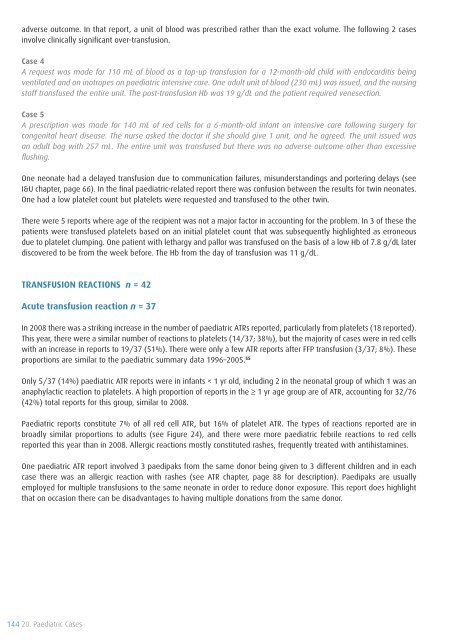SHOT Annual Report 2009 - Serious Hazards of Transfusion
SHOT Annual Report 2009 - Serious Hazards of Transfusion
SHOT Annual Report 2009 - Serious Hazards of Transfusion
Create successful ePaper yourself
Turn your PDF publications into a flip-book with our unique Google optimized e-Paper software.
adverse outcome. In that report, a unit <strong>of</strong> blood was prescribed rather than the exact volume. The following 2 cases<br />
involve clinically significant over-transfusion.<br />
Case 4<br />
A request was made for 110 mL <strong>of</strong> blood as a top-up transfusion for a 12-month-old child with endocarditis being<br />
ventilated and on inotropes on paediatric intensive care. One adult unit <strong>of</strong> blood (230 mL) was issued, and the nursing<br />
staff transfused the entire unit. The post-transfusion Hb was 19 g/dL and the patient required venesection.<br />
Case 5<br />
A prescription was made for 140 mL <strong>of</strong> red cells for a 6-month-old infant on intensive care following surgery for<br />
congenital heart disease. The nurse asked the doctor if she should give 1 unit, and he agreed. The unit issued was<br />
an adult bag with 257 mL. The entire unit was transfused but there was no adverse outcome other than excessive<br />
flushing.<br />
One neonate had a delayed transfusion due to communication failures, misunderstandings and portering delays (see<br />
I&U chapter, page 66). In the final paediatric-related report there was confusion between the results for twin neonates.<br />
One had a low platelet count but platelets were requested and transfused to the other twin.<br />
There were 5 reports where age <strong>of</strong> the recipient was not a major factor in accounting for the problem. In 3 <strong>of</strong> these the<br />
patients were transfused platelets based on an initial platelet count that was subsequently highlighted as erroneous<br />
due to platelet clumping. One patient with lethargy and pallor was transfused on the basis <strong>of</strong> a low Hb <strong>of</strong> 7.8 g/dL later<br />
discovered to be from the week before. The Hb from the day <strong>of</strong> transfusion was 11 g/dL.<br />
<strong>Transfusion</strong> reactions n = 42<br />
Acute transfusion reaction n = 37<br />
In 2008 there was a striking increase in the number <strong>of</strong> paediatric ATRs reported, particularly from platelets (18 reported).<br />
This year, there were a similar number <strong>of</strong> reactions to platelets (14/37; 38%), but the majority <strong>of</strong> cases were in red cells<br />
with an increase in reports to 19/37 (51%). There were only a few ATR reports after FFP transfusion (3/37; 8%). These<br />
proportions are similar to the paediatric summary data 1996–2005. 55<br />
Only 5/37 (14%) paediatric ATR reports were in infants < 1 yr old, including 2 in the neonatal group <strong>of</strong> which 1 was an<br />
anaphylactic reaction to platelets. A high proportion <strong>of</strong> reports in the ≥ 1 yr age group are <strong>of</strong> ATR, accounting for 32/76<br />
(42%) total reports for this group, similar to 2008.<br />
Paediatric reports constitute 7% <strong>of</strong> all red cell ATR, but 16% <strong>of</strong> platelet ATR. The types <strong>of</strong> reactions reported are in<br />
broadly similar proportions to adults (see Figure 24), and there were more paediatric febrile reactions to red cells<br />
reported this year than in 2008. Allergic reactions mostly constituted rashes, frequently treated with antihistamines.<br />
One paediatric ATR report involved 3 paedipaks from the same donor being given to 3 different children and in each<br />
case there was an allergic reaction with rashes (see ATR chapter, page 88 for description). Paedipaks are usually<br />
employed for multiple transfusions to the same neonate in order to reduce donor exposure. This report does highlight<br />
that on occasion there can be disadvantages to having multiple donations from the same donor.<br />
144 20. Paediatric Cases












